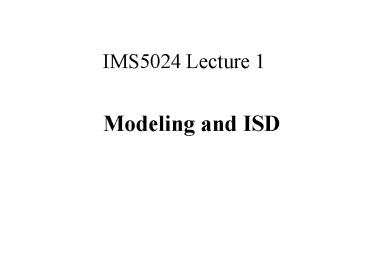IMS5024 Lecture 1 - PowerPoint PPT Presentation
1 / 18
Title:
IMS5024 Lecture 1
Description:
a model car) Sem 2, 2002. IMS5024 - Lecture 1. 8. THE NATURE OF MODELS ... Specs. Programmer. Sem 2, 2002. IMS5024 - Lecture 1. 13. What is systems development? ... – PowerPoint PPT presentation
Number of Views:29
Avg rating:3.0/5.0
Title: IMS5024 Lecture 1
1
IMS5024 Lecture 1
- Modeling and ISD
2
Contents
- Welcome, Introductions and housekeeping
- Approach
- What is Modelling?
3
Lecturer
- Dr Helana Scheepers
- Building S, 4-14
- Phone 99031066
- E-mail helana.scheepers_at_sims.monash.edu.au
4
Assessment
- Individual assignment
- Synopsis for evaluation in week 3
- Due Week 6
- Group assignment (Weekly and Modelling)
- Groups of 4 to 6
- List of names, student numbers, telephone
numbers, e-mail addresses, signatures - Presentation
- Exam
5
Pitfalls
- Read website regularly for updates on reading,
class assignments and announcements - Plagiarism
- Group work
6
Reading
- Lecture 1
- Chapter 2 of Veryard, R (1992). Information
Modelling Practical Guidance, Prentice Hall
International, UK. - Lecture 2
- Chapter 2 and 3 of Mathiassen, L and Dahlbom, B.
(1993). Computers in Context The philosophy and
practice of systems design, Blackwell Publishers,
UK. - Chapter 2 of Hirschheim, R., Klein, H. and
Lyytinen, K. (1995) Information Systems
Development and Data Modelling Conceptual and
Philosophical Foundations, Cambridge University
Press
7
WHAT IS A MODEL?
- Mathematical
- an equation (eg. Emc2)
- Symbolic/Visual
- a theory (eg. the theory of relativity)
- a hypothesis (eg. the speed of light is not a
limiting velocity) - an analogy (eg. a map)
- Physical/Iconic
- an artefact (eg. a model car)
8
THE NATURE OF MODELS
- 1. Scaling Down both in terms of size and
complexity - 2. Transfer Across representation in relative
position - 3. Workability in principle the model operates
like the original as a consequence of 12 - 4. Appropriateness to the aspect of reality
under investigation
9
THE PATHOLOGY OF MODELLING
- The model is the reality
- The model represents all of reality
10
WHY MODELS ARE USED
- Models are an agreed language by which a
diverse group can communicate about an essential
aspect of the Universe of Discourse (UoD) - It facilitates communication, and shared
understanding, between people who have a
different perspective about an aspect of reality
in which they have mutual interest.
11
MODELS AS A MEANS OF COMMUNICATION
- A descriptive, narrative model - the big picture
- An aesthetic model - what will it look like
- An environmental model - where does it fit into
the world - A designers model - how does it fit together
- A fabricators model - what components are needed
- A builders model - what do we have to build it
on - A constructors model - how do we put it together
12
The problem of communicationviews from the
coalface
Specs
Analyst
Client/user
Programmer
13
What is systems development?
- Systems development is the process of modelling
those aspects of the users physical requirements
which can take advantage of the things a
computer can do. The art of the analyst/designer
is to convert what the users needs to support
their work into the form of instructions which a
computer can follow
14
The Discourse of ISD
15
Strengths weaknesses of ALL forms of modelling
Strengths Weaknesses Simplify Omit
detail Relate to a particular purposes Inaccurate
(for some things) Relate to a specific
audiences Incomprehensible (to some audiences)
No single model can accurately communicate
information about ALL aspects of an information
system.
16
The concept of the logical equivalence
- The analyst is interested in the essential
model that depicts the essence of the system
what it must do independent of the technology or
the actual system. - To achieve this the analyst engages in a process
of abstraction, which also includes
generalisation, to identify the logical
equivalent of the physical world. When modelled,
such logical equivalents are called logical or
conceptual models. - The significance of conceptual models is that
software can only represents such models and not
the physical world.
17
Implications of systems modelling
- engineering systems are much easier to model than
information systems - what gets modelled is what gets built (and
remember all models omit some detail!) - some things are easier to model than others
- some things are un-modellable
- some models are un-buildable
- systems development requires a large variety of
models to meet the needs of different audiences
18
Using Models
- The analyst needs to
- beware of simple modelling solutions (real
organisations are not simple) - think about the things which are too complex
and/or can't be modelled - beware of 'engineering' approaches to
non-engineering systems































